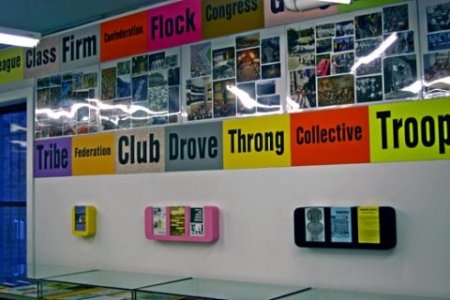
Temporary Services was in town at the end of March. They are a Chicago group which perform “services.” (Service as art, or as a social good which artists produce, was described and debated by Andrea Fraser and friends in a mid-1990s conference in Europe). Temporary Services make many ‘zines, little booklets and brochures on various topics, in accelerating profusion. Their many recent shows around the world have been basically about “servicing,” and then making a ‘zine and pushing it out. Now they have svelte, lozenge-shaped ‘zine dispensers to give these things away – forms that recall Artschwager crossed with Gonzalez-Torres. That’s artistic form both material and social…
TS made a book with Printed Matter called “Group Work.” This is no ‘zine, but the real thing, one of a number of handsome small volumes in the artist bookstore’s steady stream of new publications.
In it TS members interview the members of other art groups – among them General Idea, Wochenklauser, Haha, PAD/D, The Ex band from Amsterdam, Pedro Bell who did the album art for Parliament Funkadelic. They also wrote brief texts to profile groups like Jane, the Chicago clandestine abortion service, and the Diggers (est. ca. 1660 by Gerard Winstanley and friends, the original viral activist organization). The focus is not art but collaboration, group work of different albeit related kinds, artistic, social service, and revolutionary.
There had to be a little party for them. So we had a spaghetti dinner at the 16 Beaver Group space downtown. There TS went over the book, explicating and sharing about the collection and redaction of the contents.
I talked about historiography. To my mind it has reached that point, a high tide of artists’ collectivity, where the phenomenon is being explained and exploited. The first round of extractions (recuperations) of the surplus cultural value produced by group work is taking place. (For example, the recent “Locally Localized Gravity” show at ICA Philadelphia, showcasing mostly local collective work and boosting the city – .pdf catalog is now on line.) Claire Bishop’s new anthology of texts on “Participation” explains the dynamic behind social sculpture for a world of eager Anglophone students, in bitlets from the stars of theory and contemporary fairs (Umberto, Jorge Luis, Rirkrit, Thomas, so forth).
I remain hopeful that this wave of willful ignorance or at best two-dimensional interpretation will someday all seem like the now-forgotten hip hop ripoff film “Beat Street,” and the string of ads that followed it. Why am I hopeful? It’s because of the coming “massive change,” the necessary “worldchanging” that is already underway will make business as usual more difficult. This era of change is going to require new modes of thought and feeling. Artists will be needed to retrain humanity.
Actually I’m not worried, just annoyed at the normal imposture of so many art historians. I also used my moment with a crowd at the spaghetti dinner to plug the new book edited by Blake Stimson and Greg Sholette, “Collectivism After Modernism” (University of Minnesota Press). This is the real story to be sure, and just the beginning of serious empirical investigation of global artistic collectivism. It is really a revelation. My essay in there on New York seems like old hat, common knowledge next to the rest of the book.
Now in the artworld so many motives have become transparent. Because it’s not really the artworld anymore, but a world of cultural policy, a realm of managers and their subjects, with municipal images and real estate development plans intensely interested in the outcomes of aesthetic developments.